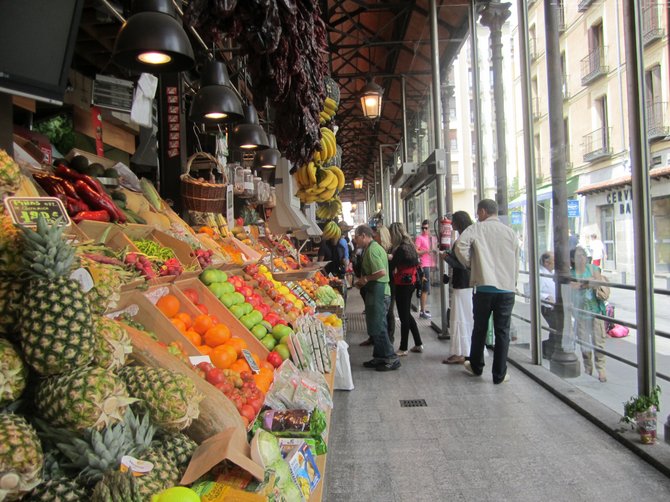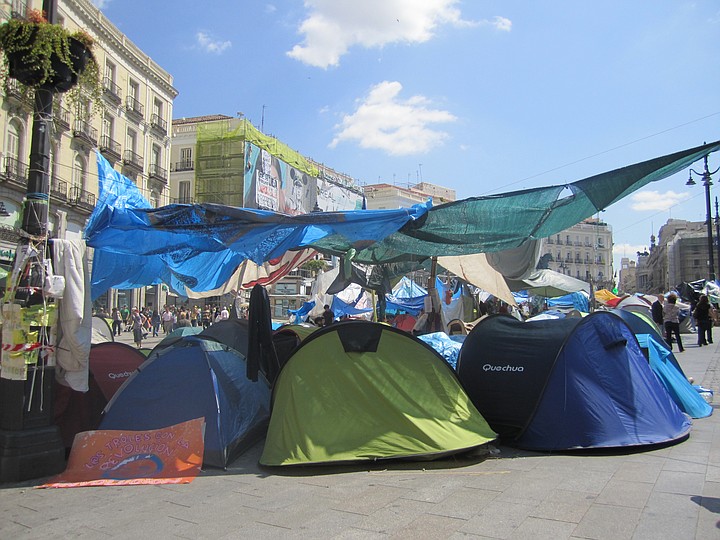 Facebook
Facebook
 X
X
 Instagram
Instagram
 TikTok
TikTok
 Youtube
Youtube

I was at the end of adjuncting three college courses, and hadn’t traveled internationally since 2006 when my husband and I went to Taipei to visit family. I had some money and time to go anywhere I wanted for a week.
Fortuitously, my sister who was studying at Cambridge University in the U.K. invited me to go to Madrid with her. I fantasized about all of the things that traveling abroad promises us: nights dining al fresco, delectable food and gorgeous wines, good music, romance and flirtation, lush cultural encounters and the attainment of euphoria via discovery, realization, enlightenment, etc...
I bought the ticket online with British Airways, the cheapest being $1180 roundtrip. I prepared by buying a travel book, dog-earing pages with locations I wanted to visit; my language skills were still lacking.
In transit, I watched my trip stretch from ten hours to eighteen and more. I sat on the airport floor, waited on the tarmac, made a pit stop in New York, sat on the tarmac, and then waited in the Heathrow terminal for my bus nearing the end of twenty-four hours of travel.
Cambridge was charming with cobbled roads, cafes, old churches turned into galleries or museums, punts floating up and down the River Cam, but I was bored. Bored in Europe! An utter transgression. There were no beautiful men (aside from the young punters), and the British staccato punctured the air around me.
From Cambridge, we took Ryan Air, one of the cheapest airlines in Europe, to Madrid. Ryan Air literally lets you on with a single bag; a purse counts as the one bag. There are no refreshments on flight, and audio commercials air the entire two hours from Cambridge to Madrid.
On our first day it was raining, but warm enough. We stopped in a tiny bakery for multicolored macarons. We lunched at a local café and tentatively ordered eggs and jamon. The population was mostly homogenous – mostly Madrilenos with a few Africans and Asians.
We booked a room via Airbnb and stayed in a third-story flat with our wonderful host, a choreographer and danseur, in Chueca, the gay district of Madrid.
Madrid is sectioned into neighborhoods like San Diego or New York City. Every neighborhood has its own charm and personality. For our purposes, we divided Madrid into three sections based on what we planned to see.
The Madrid Metro system offers different travel packages. We bought the ten-ride ticket for 9,30 €, or $12.90.
On the east side, we wandered the Calle Gran Via, their main street (think Times Square with less people and lights) and visited the Museo del Prado, which houses amazing collections of European masterpieces ranging from Greek sculptures of the muses to paintings by Bosch and Rubens.

At the Museo de Reina Sofia, an entire floor was dedicated to Yayoi Kusama’s work. The museum featured her “Infinity Room,” a dark, mirrored room strewn with miniature blinking lights as well as an entire installation of furniture dotted with glow-in-the-dark stickers.
The nearby Parque del Retiro was expansive, and included a glass cathedral in which a steep concrete slide was installed for artistic purposes.
Numerous mercados throughout Madrid provided welcome respites and tapas as well as craft beers. One of their most famous, Mercado San Miguel, housed numerous vendors offering oysters, jamón ibérico, paella and other tapas. Each tapas plate ranged from about 2-6 Euros ($2.70-8.30), and the Mercado was nearly always filled with people. Alongside the roads were numerous independent retailers selling jewelry, antique coins and tourist-trap items like fans.

Numerous tents are set up around metro stations, such as the one at Puerto del Sol. The tents house activists and protestors who live in these makeshift communes. Their activism ranges widely, from local politics to animal testing to feminism.
At the center of Madrid, the Plaza Mayor is an architecturally pleasing sight with the flat façade and expansive courtyard. Historically, the plaza was used for bull runs, public humiliation, even executions.
On the west side of central Madrid, we visited the Almudena Catedral with its striated ceiling of beautifully saturated colors, each panel gilded with gold. Visitors are able to ascend the staircase at the narthex and view the tympanum and sculptures. There are also electric prayer candles that light up with a small donation at the entrance.
We were also able to take in Atocha, the site of the 2004 terrorist metro bombings.
The overall feel of Madrid is relaxed cosmopolitan, with an intense focus on the full enjoyment of food, company and wine. Leisure is as important as work. Businessmen could be found standing on Calle Gran Via strolling about on their cell phones. People streamed out of the metro to join friends for drinks and tapas at five. Diners chatted and enjoyed their food until well past midnight.
In terms of promises, Madrid delivers. There weren’t any romantic trysts on the trip, or vague feelings of euphoria, but it was pleasurable. And we dined al fresco, enjoyed delectable food and wine, and embraced their culture – even if only as spectators this time.


I was at the end of adjuncting three college courses, and hadn’t traveled internationally since 2006 when my husband and I went to Taipei to visit family. I had some money and time to go anywhere I wanted for a week.
Fortuitously, my sister who was studying at Cambridge University in the U.K. invited me to go to Madrid with her. I fantasized about all of the things that traveling abroad promises us: nights dining al fresco, delectable food and gorgeous wines, good music, romance and flirtation, lush cultural encounters and the attainment of euphoria via discovery, realization, enlightenment, etc...
I bought the ticket online with British Airways, the cheapest being $1180 roundtrip. I prepared by buying a travel book, dog-earing pages with locations I wanted to visit; my language skills were still lacking.
In transit, I watched my trip stretch from ten hours to eighteen and more. I sat on the airport floor, waited on the tarmac, made a pit stop in New York, sat on the tarmac, and then waited in the Heathrow terminal for my bus nearing the end of twenty-four hours of travel.
Cambridge was charming with cobbled roads, cafes, old churches turned into galleries or museums, punts floating up and down the River Cam, but I was bored. Bored in Europe! An utter transgression. There were no beautiful men (aside from the young punters), and the British staccato punctured the air around me.
From Cambridge, we took Ryan Air, one of the cheapest airlines in Europe, to Madrid. Ryan Air literally lets you on with a single bag; a purse counts as the one bag. There are no refreshments on flight, and audio commercials air the entire two hours from Cambridge to Madrid.
On our first day it was raining, but warm enough. We stopped in a tiny bakery for multicolored macarons. We lunched at a local café and tentatively ordered eggs and jamon. The population was mostly homogenous – mostly Madrilenos with a few Africans and Asians.
We booked a room via Airbnb and stayed in a third-story flat with our wonderful host, a choreographer and danseur, in Chueca, the gay district of Madrid.
Madrid is sectioned into neighborhoods like San Diego or New York City. Every neighborhood has its own charm and personality. For our purposes, we divided Madrid into three sections based on what we planned to see.
The Madrid Metro system offers different travel packages. We bought the ten-ride ticket for 9,30 €, or $12.90.
On the east side, we wandered the Calle Gran Via, their main street (think Times Square with less people and lights) and visited the Museo del Prado, which houses amazing collections of European masterpieces ranging from Greek sculptures of the muses to paintings by Bosch and Rubens.

At the Museo de Reina Sofia, an entire floor was dedicated to Yayoi Kusama’s work. The museum featured her “Infinity Room,” a dark, mirrored room strewn with miniature blinking lights as well as an entire installation of furniture dotted with glow-in-the-dark stickers.
The nearby Parque del Retiro was expansive, and included a glass cathedral in which a steep concrete slide was installed for artistic purposes.
Numerous mercados throughout Madrid provided welcome respites and tapas as well as craft beers. One of their most famous, Mercado San Miguel, housed numerous vendors offering oysters, jamón ibérico, paella and other tapas. Each tapas plate ranged from about 2-6 Euros ($2.70-8.30), and the Mercado was nearly always filled with people. Alongside the roads were numerous independent retailers selling jewelry, antique coins and tourist-trap items like fans.

Numerous tents are set up around metro stations, such as the one at Puerto del Sol. The tents house activists and protestors who live in these makeshift communes. Their activism ranges widely, from local politics to animal testing to feminism.
At the center of Madrid, the Plaza Mayor is an architecturally pleasing sight with the flat façade and expansive courtyard. Historically, the plaza was used for bull runs, public humiliation, even executions.
On the west side of central Madrid, we visited the Almudena Catedral with its striated ceiling of beautifully saturated colors, each panel gilded with gold. Visitors are able to ascend the staircase at the narthex and view the tympanum and sculptures. There are also electric prayer candles that light up with a small donation at the entrance.
We were also able to take in Atocha, the site of the 2004 terrorist metro bombings.
The overall feel of Madrid is relaxed cosmopolitan, with an intense focus on the full enjoyment of food, company and wine. Leisure is as important as work. Businessmen could be found standing on Calle Gran Via strolling about on their cell phones. People streamed out of the metro to join friends for drinks and tapas at five. Diners chatted and enjoyed their food until well past midnight.
In terms of promises, Madrid delivers. There weren’t any romantic trysts on the trip, or vague feelings of euphoria, but it was pleasurable. And we dined al fresco, enjoyed delectable food and wine, and embraced their culture – even if only as spectators this time.
Comments